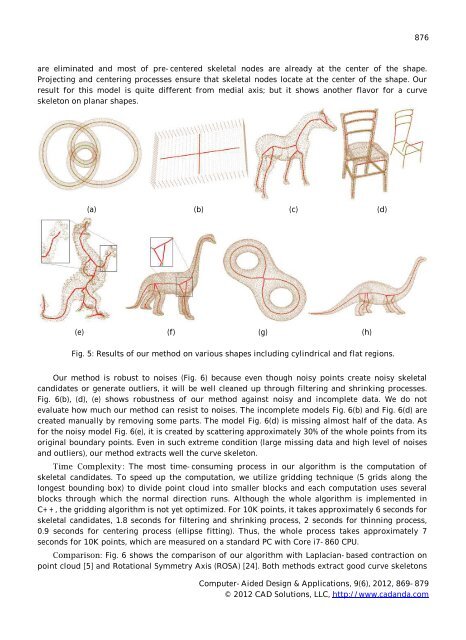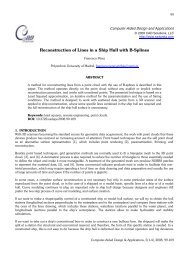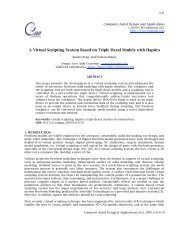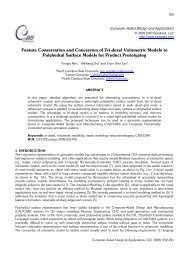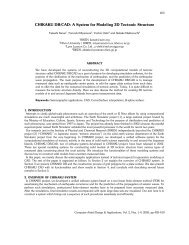A Robust and Centered Curve Skeleton Extraction from 3D Point ...
A Robust and Centered Curve Skeleton Extraction from 3D Point ...
A Robust and Centered Curve Skeleton Extraction from 3D Point ...
You also want an ePaper? Increase the reach of your titles
YUMPU automatically turns print PDFs into web optimized ePapers that Google loves.
876<br />
are eliminated <strong>and</strong> most of pre- centered skeletal nodes are already at the center of the shape.<br />
Projecting <strong>and</strong> centering processes ensure that skeletal nodes locate at the center of the shape. Our<br />
result for this model is quite different <strong>from</strong> medial axis; but it shows another flavor for a curve<br />
skeleton on planar shapes.<br />
(a) (b) (c) (d)<br />
(e) (f) (g) (h)<br />
Fig. 5: Results of our method on various shapes including cylindrical <strong>and</strong> flat regions.<br />
Our method is robust to noises (Fig. 6) because even though noisy points create noisy skeletal<br />
c<strong>and</strong>idates or generate outliers, it will be well cleaned up through filtering <strong>and</strong> shrinking processes.<br />
Fig. 6(b), (d), (e) shows robustness of our method against noisy <strong>and</strong> incomplete data. We do not<br />
evaluate how much our method can resist to noises. The incomplete models Fig. 6(b) <strong>and</strong> Fig. 6(d) are<br />
created manually by removing some parts. The model Fig. 6(d) is missing almost half of the data. As<br />
for the noisy model Fig. 6(e), it is created by scattering approximately 30% of the whole points <strong>from</strong> its<br />
original boundary points. Even in such extreme condition (large missing data <strong>and</strong> high level of noises<br />
<strong>and</strong> outliers), our method extracts well the curve skeleton.<br />
Time Complexity: The most time- consuming process in our algorithm is the computation of<br />
skeletal c<strong>and</strong>idates. To speed up the computation, we utilize gridding technique (5 grids along the<br />
longest bounding box) to divide point cloud into smaller blocks <strong>and</strong> each computation uses several<br />
blocks through which the normal direction runs. Although the whole algorithm is implemented in<br />
C+ + , the gridding algorithm is not yet optimized. For 10K points, it takes approximately 6 seconds for<br />
skeletal c<strong>and</strong>idates, 1.8 seconds for filtering <strong>and</strong> shrinking process, 2 seconds for thinning process,<br />
0.9 seconds for centering process (ellipse fitting). Thus, the whole process takes approximately 7<br />
seconds for 10K points, which are measured on a st<strong>and</strong>ard PC with Core i7- 860 CPU.<br />
Comparison: Fig. 6 shows the comparison of our algorithm with Laplacian- based contraction on<br />
point cloud [5] <strong>and</strong> Rotational Symmetry Axis (ROSA) [24]. Both methods extract good curve skeletons<br />
Computer- Aided Design & Applications, 9(6), 2012, 869- 879<br />
© 2012 CAD Solutions, LLC, http://www.cad<strong>and</strong>a.com


